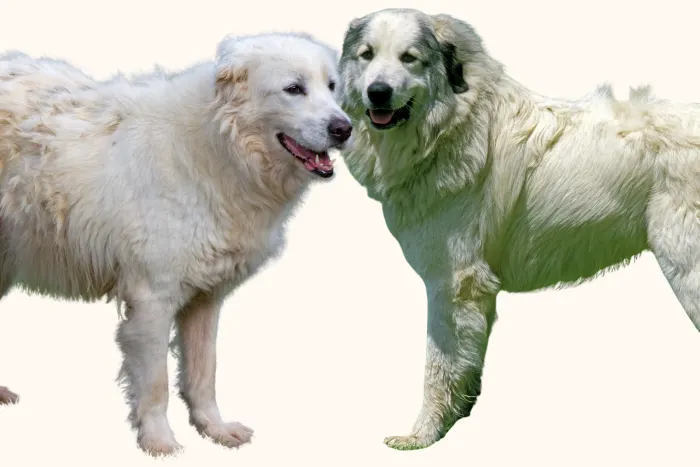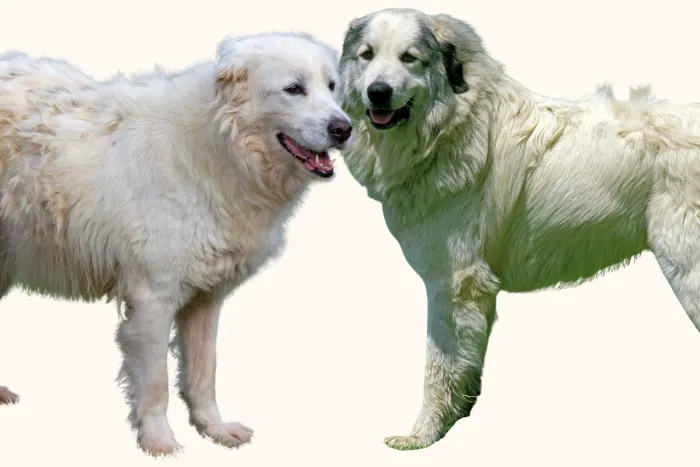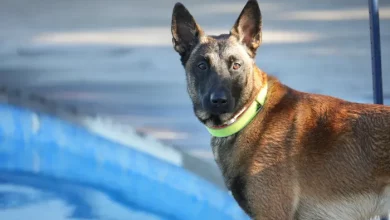Maremma Sheepdog vs Great Pyrenees: 10 Differences

The Great Pyrenees and the Maremma Sheepdogs are often confused.
It can be challenging to tell a Maremma Sheepdog apart from a Great Pyrenees due to their similarities.
Both dog breeds have oversized white coats and fluffy fur, making distinguishing them from a distance difficult.
There are still some differences between the two, particularly when comparing them side by side and paying attention to a few details.
These two dogs have a rich history that is different from their physical characteristics.
It is important to be aware of the differences between these breeds, particularly if you love both and are debating which one to choose.
No decisions should be taken lightly when it comes to dog ownership. It is important to research breeds thoroughly, especially when you consider the number of dogs that are surrendered each year in shelters.
Both the Maremma Sheepdog as well as the Great Pyrenees serve to protect livestock. These dogs are not for apartment living and thrive on farms where they have experienced owners. Here are 11 tips on how to live with and train livestock guardians.

Did you know?
The Great Pyrenees Sheepdog, as well as the Maremma Sheepdog, are believed to have some common ancestors, along with other similar-looking breeds, such as the Kuvasz from Hungary, the Polish Tatra Sheepdog, and the Akbash from Turkey.
Maremma Sheepdogs Versus Great Pyrenees: History
Both dog breeds were selectively selected as livestock guardians. However, they have different histories and come from different countries.
Maremma Sheepdog History
The Maremma Sheepdog is a descendant of ancient shepherds that have been used in Italy’s Maremma region and Abruzzi region.
Since ancient times, these dogs have been used to protect vulnerable flocks of goats and sheep from predators. Maremmas are also used to guard estates, particularly in Tuscany.
The United Kennel Club recognized the Maremma Sheepdogs on July 1, 2006
Great Pyrenees History
The Pyrenees mountains, located between France & Spain, are the origin of the Great Pyrenees.
They were used to guard flocks of sheep against predators like wolves, bears, and other livestock thieves. These dogs were used to guard French chateaux and pull milk carts.
Recommended for You
The American Kennel Club recognized the Great Pyrenees in 1933. The Great Pyrenees is more popular in North America than Maremmas, and they are probably the most popular livestock protection breed.
Maremma Sheepdogs Versus Great Pyrenees: Size
There are differences in the sizes of Great Pyrenees and Maremma Sheepdogs.
Maremma Sheepdog Size
At the withers, males should measure between 25.5 and 28.75 inches. Females are expected to measure between 23.5 and 26.5 inches.
Weight is a factor that can vary between males and females. Males can weigh up to 100 pounds, while females weigh from 66 to 88 lbs.
Great Pyrenees Size
The Great Pyrenees is expected to be slightly larger and heavier than the Maremma.
Females are 25-29 inches tall, and males range from 27-32 inches.
A male who measures 27 inches at his withers can weigh up to 100 pounds. While a woman measuring 25 inches at her withers could weigh around 85 pounds.
Maremma Sheepdogs Versus Great Pyrenees: Temperament
There are many similarities between the two dog breeds, but there can also be differences on an individual basis.
The Temperament of the Maremma Sheepdog
The United Kennel Club defines Maremmas dogs as being loyal to their owners.
They are also perceptive, which means they are able to notice subtle changes and are very attuned.
The animals are described as assertive. This means that they will not be intimidated by threats to their flocks or families and are able to take immediate action when necessary, without the need for direction from their owners.
The Maremma Sheepdog Club of America does not recommend this breed for a pet. However, in the right environment with well-informed owners and enough socialization, it may be a good choice.
The Great Pyrenees Temperament
Prys is described as confident, gentle, and affectionate by the American Kennel Club. They are generally tolerant and patient, with a quiet composure, despite their tendency to be territorial and protective.
They are fearless, independent, and strong-willed. They are loyal to both their flocks and families.
They can appear aloof or reserved to strangers, but they should not be shy, nervous, or aggressive toward humans. These signs are all considered serious in the show ring.
Maremma Sheepdogs Versus Great Pyrenees: Coats
Although the coats of Great Pyrenees and Maremma Sheepdogs may look similar from afar, they have some subtle differences.
The Maremma Sheepdog’s Coat
The coat of the Maremma is long, straight, and harsh. A curly coat can be disqualified in the show ring, even if it has a slight wave.
The longer hair around the neck creates a “collar,” and some fringes can be seen on the legs. Tail hair should be long and extend all the way up to the tip, not just on the underside.
The coat is white. However, some shades, such as pale ivory, lemon, or orange, are acceptable as long as the deviation from the white coat color does not exceed a certain level.
Solid Isabella color, Isabella patches, or black shading is not accepted. This is done to preserve the distinctive white color of this breed, which is essential for this breed’s role as a livestock guardian.
The white color was chosen to help these dogs blend in and deter predators.
The undercoat of the Maremmas is dense and woolly and sheds twice a year, in spring and fall.
The Great Pyrenees’ Coat
A curly top coat is a defect. The coat should be long, thick, and coarse. Some slight waving of the coat is acceptable. The hairs must be flat and close to the body. The undercoat is made of wool.
The coat is ruffled on the shoulders and neck, which is more noticeable in men.
You can see feathering on the thighs and backs of the legs. The feathering protects the breed’s feet and legs from rough terrain, cold weather, or wet conditions.
The tail’s longer hairs form a plume. This is formed when longer hairs flow on the underside, giving it a tapered look.
White is acceptable for coat color, as are white markings in gray, reddish-brown, badger, or other shades of brown. These can appear on the head, ears (a full face mask is fine), tail, and in a few places on the body.
A fault is considered to be any markings that cover over one-third of the body.
Great Pyrenees vs. Maremma Sheepdogs: Physical traits
Are you ready to dig deeper into the details of these two breeds? These are the characteristics of each breed according to their standards.
Maremma Sheepdog Physical Traits
General appearance: A strong-built, majestic dog that has a rustic appearance. Heavily constructed and slightly taller than wide.
Head: conical, flat, and similar to that of a Polar Bear.
Muzzle: non-pendulous lips
Teeth: Meeting in a scissors bite (with the inner faces of upper incisors closing onto the outer surfaces of lower incisors). A bite that is undershot will result in disqualification.
Nose: large, black, and with well-opened nostrils.
The eyes are almond-shaped and not large. The color of the eyes is chestnut brown or ochre. The eye rims should be black. The complete absence of pigment can be a disqualifying characteristic. The expression is vibrant and attentive.
Ears are triangular in shape, set high, and small when compared with the size of the dog. They are still very mobile despite being pendulous. Working dogs may have their ears cropped.
Feet: large. Front feet roundish, rear feet oval. Paw pads are dark.
Tail: hangs when at rest. When in motion, it is carried over the back. The end has a hook. It is considered a grave fault if the tail curls over the back.
Ten to fourteen years is the average lifespan.
Great Pyrenees Physical Traits
A dog with a majestic and elegant appearance.
Head: wedge-shaped, with an intelligent and contemplative expression. The head should be lighter than in Saint Bernards or Newfoundlands.
The upper lip is slightly covered by the lower lip. The lips are black.
A scissor-bites is preferred, but a normal bite is acceptable.
Nose: Black
The eyes are almond-shaped, with a slight oblique setting, of medium size and rich, dark brown color. The eyelids are black. From the outer corner to the base ear, there is a hairline.
Ears: Small to medium-sized V-shaped ears with a rounded end. They should be carried low, flat, and close to the face.
Front feet: arched toes, well-padded and rounded. The back feet are also rounded, well-padded, and have arched toes.
Each rear leg has two dewclaws. If they are missing, the dog is disqualified.
Tail: tail has a plume, and it is carried low when at rest. It crosses over the back to form the “wheel” when aroused. The plume may be enhanced by a shepherd’s crook. The tail can be carried over or low when trotting.
Ten to twelve years
How can you tell the difference between a Great Pyrenees dog and a Maremma dog? Ten Key Differences
There are ten main differences between the Maremma Sheepdog and Great Pyrenees.
Maremma SheepdogGreat Pyrenees
Originating from Italy (Abruzzo region)
Originating from France (French Side of Pyrenees Mountain)
General appearance: majestic-looking dogs with the rustic appearance
The elegant and majestic appearance
Men can grow up to 28.75 inches tall
Men can grow up to 32 inches tall
Men can weigh between 77 and 100 pounds
Males can weigh more than 100 pounds
Triangular ears set high
Low-set ears with a rounded tip
Chestnut brown eyes or ochre ones
Rich dark brown eyes
Conical head
Head with a wedge-shaped shape
No double dewclaw
Double dewclaw in rear leg
Solid white coat. Only shades of ivory, lemon, or orange are allowed.
White or off-white coat with grey, brown, tan, or reddish-brown markings on the ears, face, and tail.
Lifespan: 10-14 Years
Lifespan: 10- 12 years
References
United Kennel Club: Maremma SheepdogAmerican Kennel Club Breed Standard for Great PyreneesWisdom panel: Great PyreneesWisdom panel: Maremma Sheepdog
The content of this page is accurate to the best knowledge of the author and does not replace formal, individualized advice given by a qualified professional.




